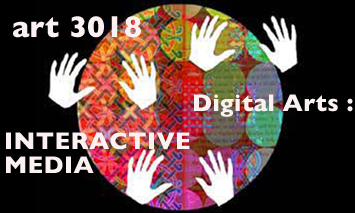|
|

|
Joellyn Rock
Assistant Professor
UMD Art & Design
office: Voss Kovach 25C
phone: 218-726-8042
email: jrock2@d.umn.edu
FALL office hours: Monday 1–4pm
www.d.umn.edu/~jrock2
|
FALL 2013 Syllabus
Art 3018 Digital Arts: Interactive Media provides an introduction to the creative use of interactive media in contemporary studio art practice. Discussion of emerging media formats and current trends in interactive art. Collaborative projects informed by conceptual dialogue in digital culture and significant works by net artists. Development of game-like interactive experiences via social networking, virtual worlds, or locative media. Experimental works may be created using open source software or other interactive design tools. Laptop required (Mac or PC).
The Interactive Media classroom is a learning laboratory for digital art processes from brainstorming through digital output. Students are encouraged to mix media, taking clues from a rich tradition of avant-garde experiments and current trends in digital art. All projects incorporate digital tools in some stage of their process, with a focus on interactivity. The class establishes a collaborative learning environment, wherein all participants will take turns sharing their expertise and discoveries in a laboratory of emerging technologies.
Interactive Art Topics Include:
Avatars, Virtual Worlds, Mobile Devices, Locative Media, Motion Interfaces, Augmented Reality, Digital Games, Play and Community, Interactive Cinema, Transmedia, Net Art, New Media Art, Social Media, Blog Art, Email Art,Software Art, Open-Source Software, Interface Aesthetics, Emerging Interactive Formats, Touch screens, Motion Capture...
|
Digital Art : Interactive Media
ART 3018 section 1
5:00 - 8:50PM Monday / Partially Online
A B Anderson Hall 335
Interactive Media B L O G
Art 3018 students will use blogs:
SET UP YOUR BLOG + LOG IN
http://blog.lib.umn.edu
Evaluation:
10% Interactive Art Topic Presentation
10% Participation & Blog Assignments
20% Project 1 Avatars + Virtual Worlds
20% Project 2 Mobile + Locative Media
20% Project 3 Motion + Interactivity
20% Project 4 Final Project Choice
Attendance Policy:
Attendance and engaged participation in all in class activities is required. Students are allowed 3 missed classes for personal needs. Final grade will go down for additional missed classes.
Art 2016 STUDENT LEARNING OUTCOMES :
•Students will be able to demonstrate knowledge of current dialogue in digital culture related to interactivity and creative artwork..
•Students will be able to demonstrate skill and innovation using interactive media, tools and processes..
•Students will be able to demonstrate their ability to analyze, interpret, critique and evaluate interactive media artworks.
|
Supplies:
• concept / sketch book
• backup / jump drive
• cd-r or dvd for digital portfolio
LAPTOP REQUIREMENT
+ technology help
Software Training / access to Lynda.com :
UMD users will log in using their University Internet ID and password in order to access training videos available on lynda.umn.edu. Lynda.com’s vast library is available 24 hours a day, seven days a week, and contains thousands of professional-grade Windows and Mac video tutorials.
Interactive Media Texts :
Choose one :
Reality is Broken by Jane McGonigal, ISBN-10: 1594202850
Internet Art by Rachel Green, Thames & Hudson (2004), ISBN-10: 0500203768
New Media Art by Mark Tribe, Taschen (2006), ISBN-10: 3822830410
Designing Interactions by Bill Moggridge, The MIT Press; (2007)
ISBN-10: 0262134748
Optional Resource: Open-Source software training such as
Getting Started with Processing [Paperback], Casey Reas, Ben Fry (Authors) Publisher: Make; 1 edition (2010), ISBN-10: 144937980X
|
Tools / Resources / Links
Interactive Media > B L O G
Software Training >Lynda.com
Moviestorm
Mozilla Popcorn
Google Maps Engine Lite
LEAP Motion
Open Source Art Software
Hack Factory
Multimedia Hub in Library 260
Shoot Studio
Digital Art Links
Photoshop Tutorials
Avatars + Virtual Worlds
Remix Culture
Augmented Reality
|
|
|
Students with disabilities:
It is the policy and practice of the University of Minnesota Duluth to create inclusive learning environments for all students, including students with disabilities. If there are aspects of this course that result in barriers to your inclusion or your ability to meet course requirements – such as time limited exams, inaccessible web content, or the use of non-captioned videos – please notify the instructor as soon as possible. You are also encouraged to contact the Office of Disability Resources to discuss and arrange reasonable accommodations. Please call 218-726-6130 or visit the DR website at www.d.umn.edu/access for more information.
|
Student Academic Integrity Policy
http://www.d.umn.edu/assl/conduct/integrity
"Academic dishonesty tarnishes UMD's reputation and discredits the accomplishments of students. UMD is committed to providing students every possible opportunity to grow in mind and spirit. This pledge can only be redeemed in an environment of trust, honesty, and fairness. As a result, academic dishonesty is regarded as a serious offense by all members of the academic community. In keeping with this ideal, this course will adhere to UMD's Student Academic Integrity Policy. This policy sanctions students engaging in academic dishonesty with penalties up to and including expulsion from the university for repeat offenders."
|
|
|
Student Conduct Code
http://www.d.umn.edu/assl/conduct/code/
The instructor will enforce and students are expected to follow the University's Student Conduct Code. Appropriate classroom conduct promotes an environment of academic achievement and integrity. Disruptive classroom behavior that substantially or repeatedly interrupts either the instructor's ability to teach, or student learning, is prohibited. Disruptive behavior includes inappropriate use of technology in the classroom. Examples include ringing cell phones, text-messaging, watching videos, playing computer games, doing email, or surfing the Internet on your computer instead of note-taking or other instructor-sanctioned activities."
|
|
|
